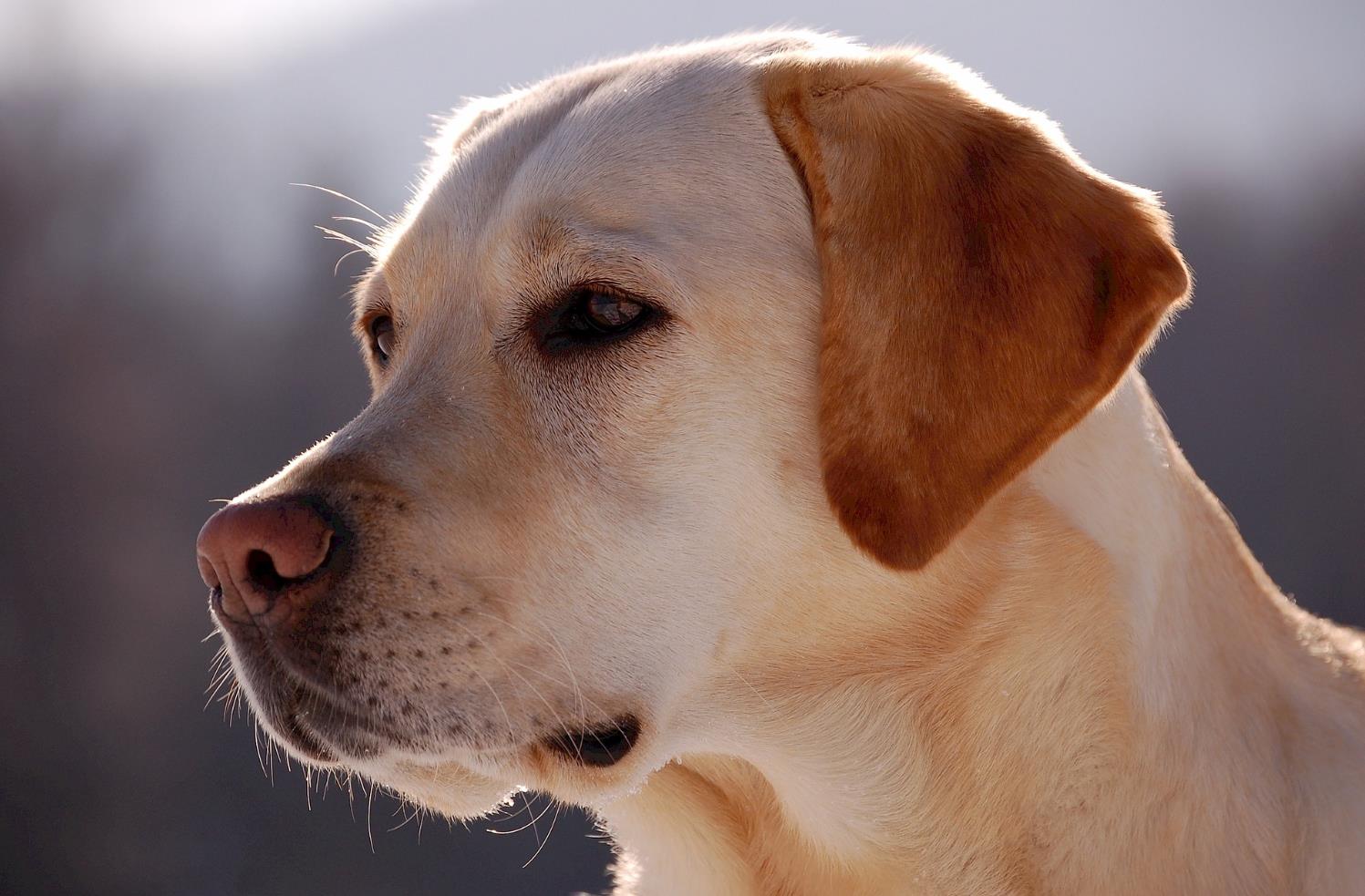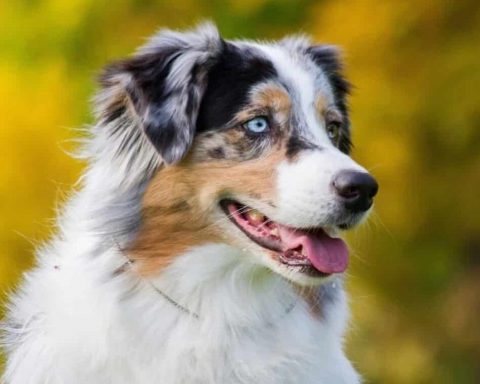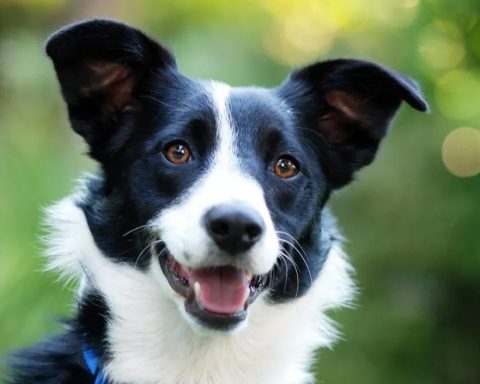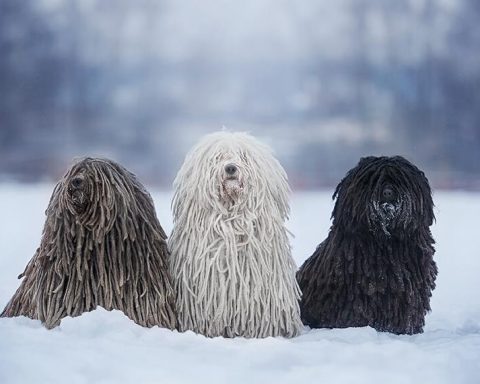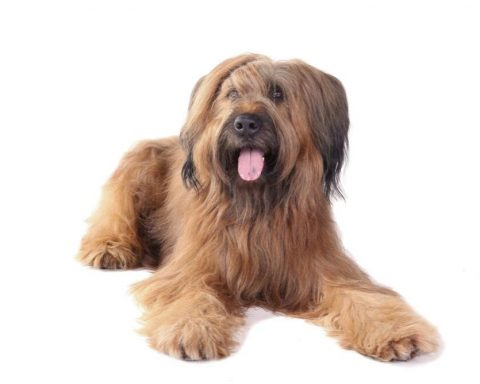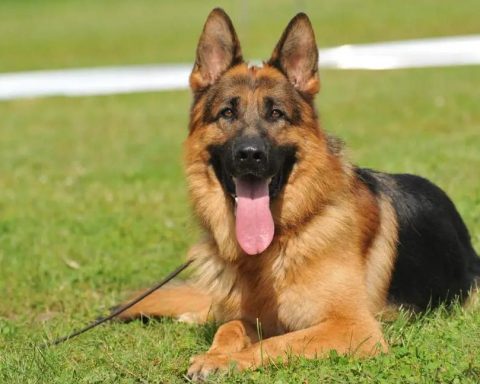A solidly constructed, medium-sized dog with short joints, his healthy, well-stabilized structure allows him to be a retrieving gun hound;
His physique and sturdy structure allow him to work long hours in tough conditions for jobs like waterfowl hunting or hunting in hilly terrain;
Characteristics and qualities that are key to his winning in competition;
His temperament also lends itself to being a domestic partner.
Physical appearance and intellectual traits show that he is groomed for use in a variety of environments ranging from chasing to searching.
The unique characteristics of the Labrador Retriever are their short, thick coat that can withstand harsh weather conditions; an “otter” tail; a well-defined head with a broad back of the head and a moderate stop; a strong jaw; and “sharp” friendly eyes that are distinctive, intelligent and temperamentally sound. He is intelligent and has a good temperament.
First and foremost is the overall condition, a Labrador Retriever should be very well coordinated and be able to work well in the ring or in the field with little or no effort.
The typical Labrador Retriever possesses qualities of elegance without being overly refined, and is well-built without being coarse or earthy. Labrador Retrievers were first bred as working gun hounds, so structure and solidity are vital.
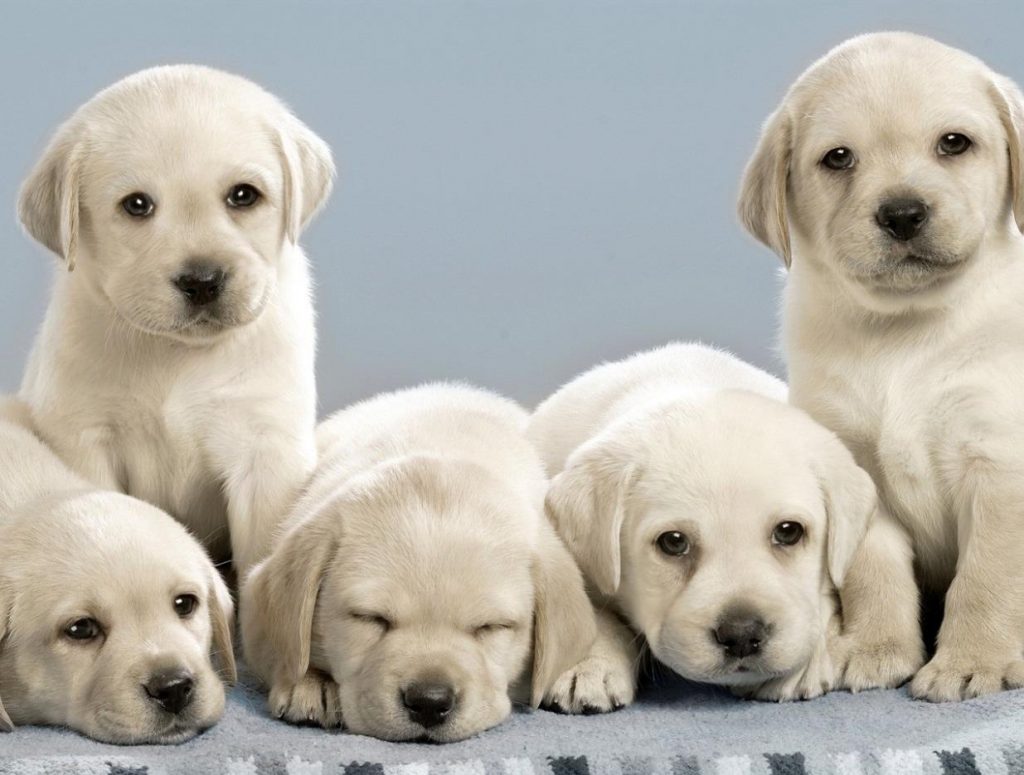
Body Type
Size: males stand about 22.5 to 24.5 inches tall at the shoulder; females stand about 21.5 to 23.5 inches tall at the shoulder. Errors of more than 0.5 inches are considered disqualifications. WEIGHT UNDER WORKING CONDITIONS: males approximately 65 to 80 pounds; females approximately 55 to 70 pounds.
The minimum shoulder heights described in the above paragraphs do not apply to puppies under 12 months of age for either males or females.
PROPORTION: Slightly shorter joints; body length (distance from the shoulder joint to the end of the hip) equal to or slightly greater than shoulder height (vertical distance from the withers to the ground). The distance from the elbow to the ground is equal to half the height of the shoulder. The chest extends to the elbows, but does not give very much.
The body must be of sufficient length to permit a straight, free and efficient stride; but he must never appear short in outline and over-long in body or tall and slender in legs.
Physique: Body and bone mass in proportion to the whole. Individuals that are thin and “useless” must be simply eliminated, and similarly, individuals that are rustic and clumsy are not desirable. The Labrador Retriever must show muscularity (well developed) for working conditions and must not be overweight.
Head
Head: The head is broad; very defined but not exaggerated. The head and front face are on faces parallel to each other and of approximately equal length. The stop is moderate and the brow is slightly prominent, so that the head is not a complete straight line to the tip of the nose. The brow bone gives emphasis to the stop. The head is well defined without a lot of flesh on the cheeks, the bones of the head are well defined, the eyes are well defined below the eyes but the cheeks are not prominent. The head shows a slight centerline; the rear occipital bone is not prominent in mature dogs. The lips must not be square or pendulous. But form a curve toward the throat. A wedge-shaped head, or a hind head, with a long, narrow muzzle is just as wrong as a stubby head and thick cheeks. The jaws are strong but not slender, and the muzzle is neither long and narrow nor short and thick.
NOSEGLASSES: The nose-glasses are broad and the nostrils are very well developed. Nasal mirrors are black in yellow or black dogs, brown in chocolate-colored dogs, and fading of the nasal mirrors to a light shade is not a defect. A nose mirror that is thoroughly pink or a nose mirror that lacks any pigmentation is a disqualification.
TEETH: Teeth are strong and straight, with a clipped bite and. A clipper bite and is also acceptable but not ideal. Teeth with a protruding upper jaw bite, protruding lower jaw bite, or teeth that fail to align are serious defects. Complete dentition is most desirable; lack of molars or premolars is a serious defect.
Ears: Hanging, moderately close to the head, rather backward, slightly below the head; slightly above the level of the eyes. The ears should not be too large or heavy, but in proportion to the head and extending to the inside of the eyes when drawn forward.
Eyes: Sharp, friendly eyes show good temperament; intelligence and quick wit characterize this breed. The eyes are medium sized and well parted in position, neither protruding nor deeply positioned. Black or yellow dogs have brown eye color and chocolate colored dogs have brown or hazel eye color. Black or yellow eyes make the expression harsh and unwanted. Small eyes, eyes positioned too close together, and round, protruding eyes are not typical for the breed. Black or yellow Labrador Retrievers have black eye rings and chocolate Labrador Retrievers have brown eye rings. Lack of pigmentation in the eye rings is a disqualification.
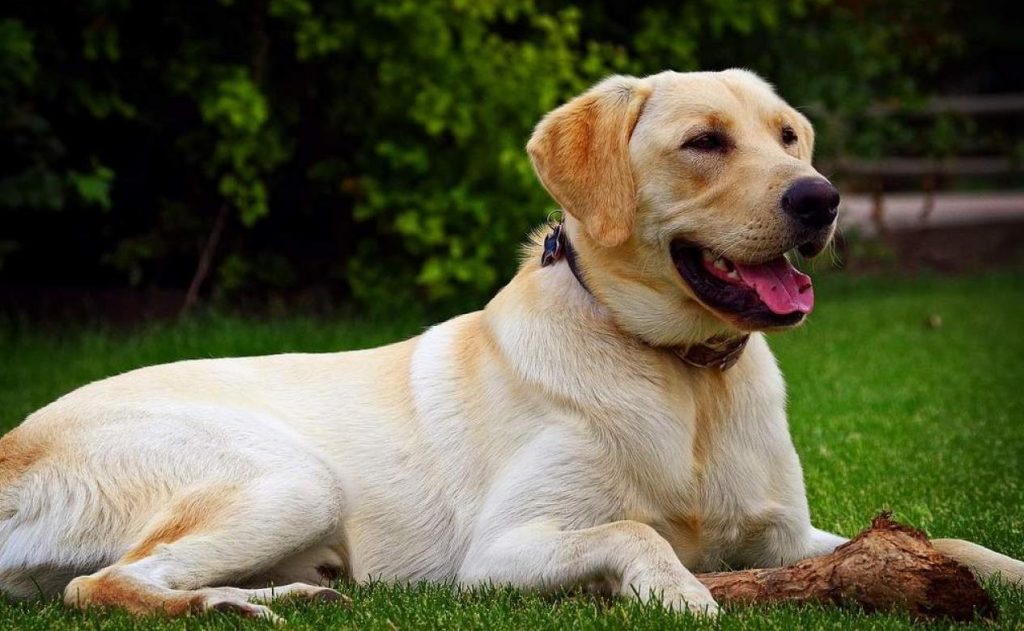
Neck, Backline, Body
NECK: The neck has the correct length allowing him to do his retrieving work with ease. It is well muscled and free of bulk. The neck rises firmly from the shoulder blades and is moderately rounded. A short, thick neck or “goat’s neck” is wrong.
Dorsal Line: The back is firm and the dorsal line (from the withers to the hips) remains level when standing or during exercise. In any case, as a sporting dog, the loin clearly shows flexibility.
Body: The Labrador Retriever has short joints that appear refined from the well-supported ribs to the moderately broad chest. The Labrador Retriever chest should not be so narrow that it appears empty between the forelegs; nor should it be so broad that it appears like a bulldog’s forequarters. The correct chest configuration is one that is slightly tapered between the front legs, allowing free movement of the front limbs. It is wrong to have a chest that is too wide or too narrow, preventing effective movement and lasting endurance. A flat chest is not typical of the breed. Equally inappropriate are overly rounded ribs or barrel chests. The underbelly curve of the adult dog is almost straight or slightly lifted. The loin is short, broad and strong, extending to a very well developed and powerful hindquarters. When viewed from the side, the Labrador Retriever has a very well developed, but not exaggerated, forechest.
Tail: The tail is a unique feature of the breed. It is very thick at the root and tapers towards the tip. Medium in length, the length must not extend beyond the fly joints. The tail has no feathered hairs and is surrounded by the thick, short, dense coat of the Labrador Retriever, resulting in a peculiarly rounded appearance, described as an “otter” tail. The tail is an extension of the dorsal line at rest or during exercise. It may be carried happily, but not curled behind the back, and a tail that is excessively short or excessively long and thin is a serious defect. The tail is quite in harmony with the Labrador Retriever as a whole, forming a flowing curve from the top of the head to the tip of the tail. A broken tail or other alteration of the natural length or position of the tail is a disqualification.
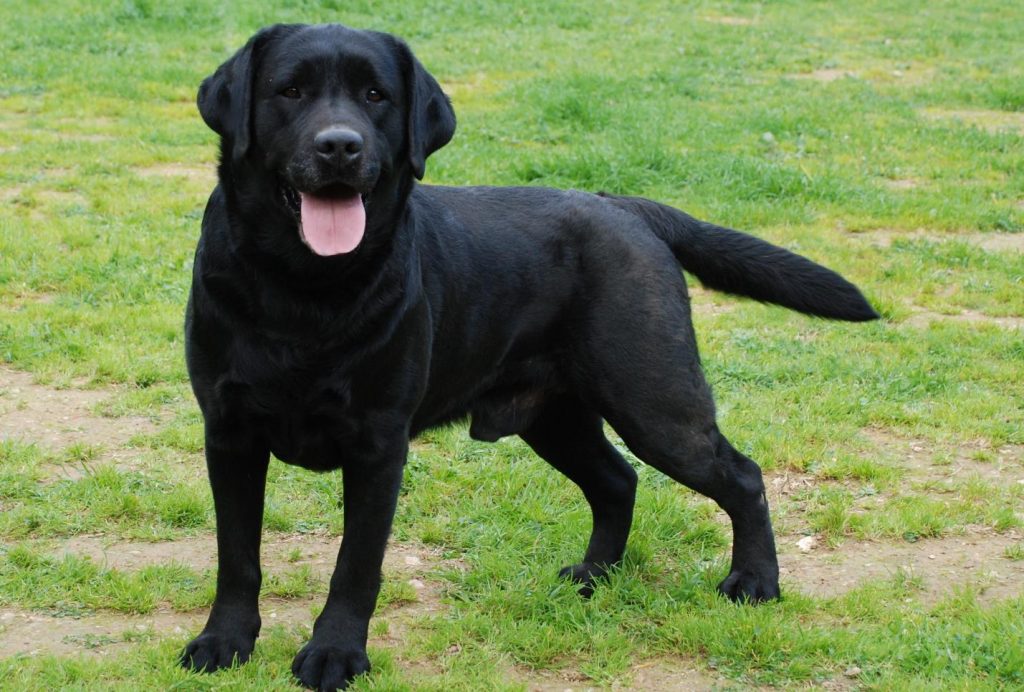
Forequarters
The forequarters are well muscled, very neat and harmonized with the hindquarters. Scapula: The scapula is tilted back, long and sloping, at an angle of approximately 90 degrees to the upper arm, permitting him to move the forelimb with ease while achieving the greatest degree of extension. Ideally the length of the scapula is approximately equal to the length of the upper arm bone. An overly straight scapula, an overly short upper arm bone, excessively heavy muscles, or resistant shoulders, all areas that impede the stretchability of the movement, are incorrect.
FRONT LEG: When viewed from the front, the front leg is straight and strongly boned. Too much or too little bone is not needed. Short legs or heavy bone are not typical of the breed. When viewed from the side, the elbows are located just below the rump of the horse’s shoulders, and the forelegs are perpendicular to the ground and in the proper position under the body. The elbows are close to the ribs and show no signs of laxity. Protruding or “stretched” elbow joints, which impede the movement of the stretches, are serious defects. The stifle is strong and short, and appears to be slightly tilted in relation to the vertical leg.
Foot claws: strong and compact, with rounded arches of the toes and well-developed pads. Wolf paws may be excised. Open paws, hare’s feet, protruding joints, or paws curved inward or turned outward are considered serious defects.
Hindquarters
The Labrador Retriever’s hindquarters are broad, well-muscled, and very well defined from the hips to the fly joints, with well-turned knees and short, strong fly joints. Viewed from behind, the hind legs are straight and parallel to each other. When viewed from the side, the hindquarters are angled in harmony with the forequarters.
The hind legs are strong in bone and muscle, the knee joints are moderately angled, and the thighs are strong and clear.
Knee joints are strong and do not slide when moving or standing.
Flying knuckles are strong and low and do not slide or overextend when in motion or standing. The knee and fly joints are angled to an optimal position that balances propulsion and traction well.
When standing, the toes of the hind limbs are slightly further back than the hips. An excessive angle, resulting in a sloping dorsal line, is not typical of the breed.
FOOT CLAWS: Sturdy and compact, with rounded arched toes and well-developed foot pads. Cow limbs, extended flying knuckles, sickle legs or excessive angles are serious structural problems and are defective.
Coat
The coat of the Labrador Retriever is distinctive. It is short, straight and very dense, and when touched, gives the fingers a rather hard feeling.
The Labrador Retriever has a soft, weather-resistant undercoat that protects it in water, in cold places, and in a variety of terrain conditions. A slightly wavy coat on the back is permissible. A woolly coat, a soft silky coat, or a sparse and smooth coat is not characteristic of the breed and is a serious defect.
Color
Labrador Retrievers come in black, yellow, and chocolate brown. Any other color or combination of colors is a disqualification. Small white patches on the chest are permissible but undesirable. White hair due to age or scarring should not be misinterpreted as spots. BLACK: All black, black with spots or black with brown markings are disqualifications. YELLOW: Yellow is permitted from fox red to light cheese, varying in shades of color on the ears, back, and underbelly. CHOCOLATE: Allowed from light chocolate to dark chocolate. Chocolate with spots or brown markings is out of order.
Movement
The Labrador Retriever moves with a stretch and ease. When observing a dog coming toward them, the elbows show no signs of being outward. More accurately, the elbows and legs appear neat relative to the body, not excessively close together.
Straight forward, there is no pacing or intertwining of steps. The legs form a straight line with all parts moving in the same plane.
Conversely, when viewed from behind, a significant impression is that the hind legs move almost in the same parallel line as the front legs, with the flying knuckles fully engaged in their work, well bent and appearing very strong.
Viewed from the side, the scapulae move freely and with great ease, the forelegs are stretched forward and close to the ground, the short, undulating movements, and the high lifting of the knees show the scapulae to be over-straightened, the paddling movements show a long, weak stifle, and the short, doleful hindquarter gait shows an over-straightening of the hindquarter structure; all of which are considered to be serious defects.
Faulty gaits include: intertwining steps, circling to the side, staggering, high leg movements, paddling movements, and short, undulating movements. All of these are classified as serious defects.
Temperament
The temperament of a true Labrador Retriever is as distinctive as the breed’s “otter” tail.
The ideal temperament is one that is gentle, loves to go out, is naturally easy to train, eager to please its owner, and is not aggressive toward humans or other animals.
The Labrador Retriever is very attractive to people and his refined demeanor, intelligence and adaptability make him an ideal dog.
Aggressive tendencies toward humans or other animals, or obvious signs of shyness in adult dogs, are considered serious defects.
Disqualification
- any deviation from the height range specified in the standard.
- Overall pink nose or nosepiece lacking any pigmentation.
- Lack of pigmentation in the eye rings.
- A broken tail or any other means of altering the natural length and posture of the tail.
- Any color or combination of colors other than black, yellow, or chocolate brown as described in the standards.
